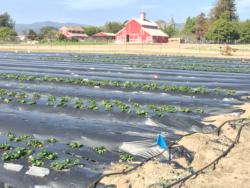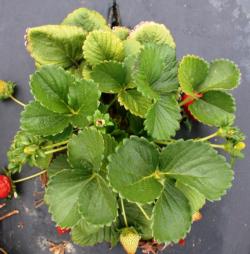Strawberries and Other Berries
Measuring the Impact of Entomopathogenic Fungi on Strawberry Plant Health and Yield

Entomopathogenic fungi such as Beauveria bassiana, Isaria fumosorosea, and Metarhizium brunneum are primarily used for managing arthropod pests. However, recent studies conducted in various parts of the world suggest that these pathogens could be doing more than pest management by improving plant growth and defenses. They are also known to antagonize certain plant pathogens. In my preliminary studies B. bassiana and M. brunneum either promoted strawberry plant health or the ability to withstand arthropod infestations. My field studies have also demonstrated that B. bassiana could play a significant role in strawberry IPM. If these fungi could be used to promote plant health and growth in addition to pest management, they will play an important role in crop production and crop protection. This is particularly important with an increasing need for alternative strategies for soilborne pathogens as methyl bromide phases out. Additionally an approach to utilize entomopathogenic fungi for multiple purposes could be very useful for organic strawberries which have limited pest and disease management options. This project aims at comparing three entomopathogenic fungi with two commercial microbial enhancers that promote plant health and yield. Plant growth, health, and yield will be monitored periodically to determine the efficacy of the treatments.
Improving Irrigation and Nitrogen Management of Strawberry Production in Ventura County

Strawberry is the leading commodity for gross value in agriculture in Ventura County and accounts for almost one third ($691 million) of the production in California. Along with the significant economic impact and steady increase in value, strawberry production has a potential for adverse impact on the environment. Growers along the coastal regions of California are under severe regulatory pressure to limit off-site movement of nitrate into ground and surface water. In order to comply with such requirements, growers will need to rely on locally created information of nitrogen (N) and water usage that can guide and support fertilization and water management decisions. Therefore, this project proposes to develop data on water and N management of strawberry crop for the specific conditions in Ventura County. Data development would fill gaps in information needed to provide comprehensive recommendations on water and N fertilizer, and used to expand CropManage, an online decision support tool for N fertilizer and water management. These gaps include crop coefficients for irrigation scheduling and seasonal crop N uptake patterns used for fertilizer recommendations. Data will be collected from commercial fields and major varieties grown in Ventura County. Aboveground biomass, canopy development and root depth will be collected periodically throughout an entire growing season. The outcomes of this project could reduce agriculture losses of nitrate to ground and surface water, protecting drinking water supplies from harmful nitrate levels, reduce over-draft of ground water supplies and improve the sustainability of strawberry production, critical to Ventura County’s economy.

